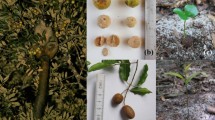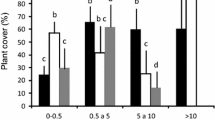Abstract
Forest destruction and disturbance can have long-term consequences for species diversity and ecosystem processes such as seed dispersal. Understanding these consequences is a crucial component of conserving vulnerable ecosystems. In the heavily fragmented and disturbed Kakamega Forest, western Kenya, we studied seed dispersal of Prunus africana (Rosaceae). In the main forest, five forest fragments, and differently disturbed sites, we quantified the overall frugivore community as an indicator for species diversity. Furthermore, we determined the frugivores on 28 fruiting P. africana trees, estimated seed dispersal, crop size and the general fruit availability of surrounding trees. During the overall frugivore census we recorded 49 frugivorous species; 36 of them were observed visiting P. africana trees and feeding on their fruits. Although overall frugivore species richness was 1.1 times lower in fragments than in main forest sites and 1.02 times higher in highly disturbed than in less disturbed sites, P. africana experienced 1.1 times higher numbers of frugivores in fragments than in main forest sites and 1.5 times higher numbers of frugivores in highly disturbed than in less disturbed sites. Correspondingly, seed dispersal was 1.5 times higher in fragments than in main forest sites and 1.5 times higher in more disturbed than less disturbed sites. Fruit availability of surrounding trees and crop size influenced the number of visitors to some degree. Thus, the number of dispersed seeds seemed to be slightly higher in fragmented and highly disturbed sites. This indicates that loss of single species does not necessarily lead to a decrease of ecosystem services. However, loss of diversity could be a problem in the long term, as a multitude of species might act as buffer against future environmental change.





Similar content being viewed by others
References
Aizen MA, Feinsinger P (1994) Forest fragmentation, pollination, and plant reproduction in a chaco dry forest, Argentina. Ecology 75:330–351
Andresen E, Levey DJ (2004) Effects of dung and seed size on secondary dispersal, seed predation, and seedling establishment of rain forest trees. Oecologia 139:45–54
Asquith NM, Wright SJ, Clauss MJ (1997) Does mammal community composition control recruitment in neotropical forests? Evidence from Panama. Ecology 78:941–946
Balcomb SR, Chapman CA (2003) Bridging the gap: influence of seed deposition on seedling recruitment in a primate-tree interaction. Ecol Monogr 73:625–642
Beentje H (1994) Kenya’s trees, shrubs and lianas. National Museums of Kenya, Nairobi
Bennun L, Dranzoa C, Pomeroy D (1996) The forest birds of Kenya and Uganda. J East Afr Nat Hist 85:23–48
Bleher B, Böhning-Gaese K (2001) Consequences of frugivore diversity for seed dispersal, seedling establishment and the spatial pattern of seedlings and trees. Oecologia 129:385–394
Bleher B, Uster D, Bergsdorf T (2005) Assessment of the status and management effectiveness in Kakamega Forest, Kenya. Biodivers Conserv (published online)
Brotons L, Mønkkønen M, Martin JL (2003) Are fragments islands? Landscape context and density-area relationships in boreal forest birds. Am Nat 162:343–357
Charlesworth D, Charlesworth B (1987) Inbreeding depression and its evolutionary consequences. Ann Rev Ecol Syst 18:237–268
Cole FR, Loope LL, Medeiros AC, Raikes JA, Wood CS (1995) Conservation implications of introduced game birds in high-elevation Hawaiian shrubland. Conserv Biol 9:306–313
Cordeiro NJ, Howe HF (2003) Forest fragmentation severs mutualism between seed dispersers and an endemic African tree. Proceedings of the National Academy of Sciences of the United States of America 100:14052–14056
Cunningham AB, Mbenkum FT (1993) Sustainability of harvesting Prunus africana bark in Cameroon. In: People and plants working paper, 2. UNESCO, Paris
Da Silva JMC, Tabarelli M (2000) Tree species impoverishment and the future flora of the Atlantic forest of northeast Brazil. Nature 404:72–74
Da Silva JMC, Uhl C, Murray G (1996) Plant succession, landscape management, and the ecology of frugivorous birds in abandoned Amazonian pastures. Conserv Biol 10:491–503
Daily GC, Ehrlich PR, Sánchez-Azofeifa GA (2001) Countryside biogeography: use of human-dominated habitats by the avifauna of southern Costa Rica. Ecol Appl 11:1–13
Debinski DM, Holt RD (2000) A survey and overview of habitat fragmentation experiments. Conserv Biol 14:342–355
Dick CW (2001) Genetic rescue of remnant tropical trees by an alien pollinator. Proc R Soc Lond Ser B Biol Sci 268:2391–2396
Didham RK, Ghazoul J, Stork NE, Davis AJ (1996) Insects in fragmented forests: a functional approach. Trends Ecol Evol 11:255–260
Donoso DS, Grez AA, Simonetti JA (2004) Effects of forest fragmentation on the granivory of differently sized seeds. Biol Conserv 115:63–70
Dranzoa C (1998) The avifauna 23 years after logging in Kibale National park, Uganda. Biodivers Conserv 7:777–797
Fashing PJ (2004) Mortality trends in the African cherry (Prunus africana) and the implications for colobus monkeys (Colobus guereza) in Kakamega Forest, Kenya. Biol Conserv 120:449–459
Fry CH, Keith S (2004) The birds of Africa, vol VII. Christopher Helm, London
Fry CH, Keith S, Urban EK (1988) The birds of Africa, vol III. Academic, London
Fry CH, Keith S, Urban EK (2000) The birds of Africa, vol VI. Academic, London
Garcia D, Ortiz-Pulido R (2004) Patterns of resource tracking by avian frugivores at multiple spatial scales: two case studies on discordance among scales. Ecography 27:187–196
Githiru M, Lens L, Bennun LA, Ogol C (2002) Effects of site and fruit size on the composition of avian frugivore assemblages in a fragmented Afrotropical forest. Oikos 96:320–330
Graham C, Martinez-Leyva JE, Cruz-Paredes L (2002) Use of fruiting trees by birds in continuous forest and riparian forest remnants in Los Tuxtlas, Veracruz, Mexico. Biotropica 34:589–597
Guindon CF (1996) The importance of forest fragments to the maintenance of regional biodiversity in Costa Rica. In: Schelhas J, Greenberg R (eds) Forest patches in tropical landscapes. Island Press, Washington, pp 168–186
Guitian J, Fuentes M, Bermejo T, Lopez B (1992) Spatial variation in the interactions between Prunus mahaleb and frugivorous birds. Oikos 63:125–130
Hall JB, O’Brien EM, Sinclair FL (2000) Prunus africana: a monograph. School of Agricultural and Forest Sciences Publication Number 18. University of Wales, Bangor, pp 104
Herrera CM (2000) Measuring the effects of pollinators and herbivores: Evidence for non-additivity in a perennial herb. Ecology 81:2170–2176
Howe HF (1984) Implications of seed dispersal by animals for tropical reserve management. Biol Conserv 30:261–281
JMP (1995) JMP statistics and graphics guide. Version 3.1. SAS Institute Inc., Cary
Keith S, Urban EK, Fry CH (1992) The birds of Africa, vol IV. Academic, London
KIFCON (1994) Kakamega Guide. The official guide. Kenya Indigenous Forest Conservation Programme, Nairobi
Kingdon J (1997) The Kingdon field guide to African mammals. Academic, London
Kruess A, Tscharntke T (1994) Habitat fragmentation, species loss, and biological-control. Science 264:1581–1584
Laurance WF, Delamonica P, Laurance SG, Vasconcelos HL, Lovejoy TE (2000) Rainforest fragmentation kills big trees. Science 404:836
Ledig FT (1986) Heterozygosity, heterosis, and fitness in outbreeding plants. In: Soulé ME (ed) Conservation biology. The science of scarcity and diversity. Sinauer Associates, Sunderland, pp 77–104
Levey DJ (1988) Spatial and temporal variation in Costa Rican fruit-eating bird abundance. Ecol Monogr 58:251–269
Levey DJ, Benkman CW (1999) Fruit-seed disperser interactions: timely insights from a long-term perspective. Trends Ecol Evol 14:41–43
Loreau M, Naeem S, Inchausti P, Bengtsson J, Grime JP, Hector A, Hooper DU, Huston MA, Raffaelli D, Schmid B, Tilman D, Wardle DA (2001) Ecology – biodiversity and ecosystem functioning: current knowledge and future challenges. Science 294:804–808
Loveless MD, Hamrick JL (1984) Ecological determinants of genetic structure in plant populations. Annu Rev Ecol Syst 15:65–95
Luck GW, Daily GC (2003) Tropical countryside bird assemblages: richness, composition, and foraging differ by landscape context. Ecol Appl 13:235–247
Makana JR, Thomas SC (2004) Dispersal limits natural recruitment of African mahoganies. Oikos 106:67–72
Martinez-Garza C, Gonzalez-Montagut R (1999) Seed rain from forest fragments into tropical pastures in Los Tuxtlas, Mexico. Plant Ecol 145:255–265
Mitchell N (2004) The exploitation and disturbance history of Kakamega Forest, western Kenya. In: Bleher B, Dalitz H (eds) BIOTA-East Report No 1, vol 20. Bielefelder Ökologische Beiträge, Bielefeld
Murphy HT, Lovett-Doust J (2004) Context and connectivity in plant metapopulations and landscape mosaics: does the matrix matter? Oikos 105:3–14
Nason JD, Hamrick JL (1997) Reproductive and genetic consequences of forest fragmentation: Two case studies of Neotropical canopy trees. J Hered 88:264–276
Oberrath R, Böhning-Gaese K (2001) The Signed Mantel test to cope with autocorrelation in comparative analyses. J Appl Stat 28:725–736
Pizo MA (1997) Seed dispersal and predation in two populations of Cabralea canjerana (Meliaceae) in the Atlantic Forest of southeastern Brazil. J Trop Ecol 13:559–577
Restrepo C, Gomez N (1998) Responses of understory birds to anthropogenic edges in a Neotropical montane forest. Ecol Appl 8:170–183
Restrepo C, Gomez N, Heredia S (1999) Anthropogenic edges, treefall gaps, and fruit-frugivore interactions in a neotropical montane forest. Ecology 80:668–665
Rey PJ (1995) Spatiotemporal variation in fruit and frugivorous bird abundance in olive orchards. Ecology 76:1625–1635
Santos T, Tellería JL (1994) Influence of Forest Fragmentation on Seed Consumption and Dispersal of Spanish Juniper Juniperus thurifera. Biol Conserv 70:129–134
Scheiner SM, Gurevitch J (2001) Design and analysis of ecological experiments, 2nd edn. Oxford University Press, New York
Schippmann U (2001) Medicinal plants significant trade CITES Projekt S - 9. In: Scripten B (ed) Plants Committee Document PC9 9.1.3 (rev.), vol 39. BFN - German Federal Agency for Nature Conservation, pp 51–58
Schupp EW (1993) Quantity, quality and the effectiveness of seed dispersal by animals. Vegetatio 107(108):15–29
Simons AJ, Dawson IK, Duguma B, Tchoundjeu Z (1998) Passing problems: prostate and Prunus. Herbalgram 43:49–53
Smouse PE, Long JC, Sokal RR (1986) Multiple regression and correlation extensions of the Mantel Test of matrix correspondence. Syst Zool 35:627–632
StatSoft, Inc. (2001) STATISTICA for Windows (Computer program manual). Tulsa
Steffan-Dewenter I, Munzenberg U, Tscharntke T (2001) Pollination, seed set and seed predation on a landscape scale. Proc R Soc Lond Ser B Biol Sci 268:1685–1690
Sun C, Ives AR, Kraeuter HJ, Moermond TC (1997) Effectiveness of three turacos as seed dispersers in a tropical montane forest. Oecologia 112:94–103
Tsingalia MH (1989) Variation in seedling predation and herbivory in Prunus africana in the Kakamega Forest, Kenya. Afr J Ecol 27:207–217
Tsingalia MH (1990) Habitat disturbance, severity and patterns of abundance in Kakamega Forest, western Kenya. Afri J Ecol 28:213–226
Turner IM, Corlett RT (1996) The conservation value of small, isolated fragments of lowland tropical rain forest. Trends Ecol Evol 11:330–333
Urban EK, Fry CH, Keith S (1986) The birds of Africa, vol II. Academic, London
Urban EK, Fry CH, Keith S (1997) The birds of Africa vol V. Academic, London
Wenny DG (2001) Advantages of seed dispersal: A re-evaluation of directed dispersal. Evol Ecol Res 3:51–74
Westcott DA, Graham DL (2000) Patterns of movement and seed dispersal of a tropical frugivore. Oecologia 122:249–257
Whitmore TC (1997) Tropical forest disturbance, disappearance and species loss. In: Laurence WL, Bieregaard ROJ (eds) Tropical forest remnants: Ecology, management, and conservation of fragmented communities. University of Chicago Press, Chicago, pp 3–12
Whitney KD et al (1998) Seed dispersal by Ceratogymna hornbills in the Dja Reserve, Cameroon. J Trop Ecol 14:351–371
Willson MF (1992) The ecology of seed dispersal. In: Fenner M (ed) Seeds. The ecology of regeneration in plant communities. CAB International, Wallingford
Zimmerman DA, Turner DA, Pearson DJ (1998) Birds of Kenya and northern Tanzania. Christopher Helm, London
Acknowledgements
We thank the KWS and the FD for their permission to work in Kakamega Forest. We are grateful to N. Sajita, J. M. Kirika, F. B. Munyekenye and S. Rösner for field work, Karin v. Ewijk and Gertrud Schaab for GIS support and E. Griebeler, M. Veith, F.A. Voigt and four anonymous referees for valuable comments on earlier drafts of the manuscript. The study is part of the Ph.D. thesis of N. Farwig at the University of Mainz. Financial support was provided by the BMBF (Biota East Africa 01LC0025).
Author information
Authors and Affiliations
Corresponding author
Additional information
Communicated by Ingolf Steffan-Dewenter
Rights and permissions
About this article
Cite this article
Farwig, N., Böhning-Gaese, K. & Bleher, B. Enhanced seed dispersal of Prunus africana in fragmented and disturbed forests?. Oecologia 147, 238–252 (2006). https://doi.org/10.1007/s00442-005-0288-9
Received:
Accepted:
Published:
Issue Date:
DOI: https://doi.org/10.1007/s00442-005-0288-9




